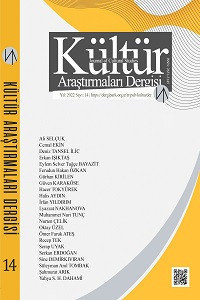Karşıtlıktan Yanlılığa: Yazar Adlı Eserde Heteronormativiteye Mecburi Bir Teslimiyet
Kuir teorinin bir alt dalı olan heteronormativite, heteroseksüel eylemlerin zamanla yerleşik hale gelen çeşitli davranış kalıpları tarafından cinsel akışkanlıktan üstün tutularak meşrulaştırılması olarak ortaya çıkmıştır. Topluma yerleşmiş olan heteronormativitenin toplum tarafından benimsenmesi, daha az ayrıcalık tanınan cinsel yönelimleri gölgede bırakarak, bu azınlık grupların toplumdaki temsilini ve yansımasını engellemektedir. Bir sanat türü olarak tiyatro, sahnede bu tarzda oyunlar sergileyerek veya en azından sözde anormal cinsel eğilimleri olan bireylerin endişelerini dile getirerek cinsel yönelimlerin çeşitliliğini ortaya koyma aracı olarak hizmet eder. Yine de heteronormativite, The Writer’da olduğu gibi, oyun yazarlarının bir oyunun seyirciye hitap etme gerekliliğini eleştirmesine rağmen üstün gelmektedir. Bu meta dramada eşcinsel eğilimli kadın Yazar ile geleneksel zihniyete sahip erkek Yönetmen arasındaki güç mücadelesi türbülansa neden olur ve aralarındaki iletişimin frekansını şiddetlendirir. Yazar’ın eşcinsel bir sahneyi mistik bir ortamda sahneleyerek heteroseksüelliği doğallıktan çıkarma çabalarına rağmen girişimi Yönetmen tarafından zorluklarla karşılaşır ve örtük olarak heteronormatif bir biçimde sahne bulur. Dolayısıyla, Yazar’ın lezbiyen çiftine cinsiyet ikiliklerinin dayatılması, heteronormativitenin hem Hickson’ın hem de Writer’ın oyunlarının sonunda da görüldüğü gibi oyunun tamamına nasıl yerleşmiş olduğunu ve heteronormatif oluşumlara karşı çıkan Yazar’ın derin inançlarında nasıl hakimiyet kurduğunu gözler önüne serer.
Anahtar Kelimeler:
heteronormativite, kuir, ataerkillik, Yazar, Ella Hickson
From Anti to Pro: An Imperious Non-Resistance to Heteronormativity in The Writer
Heteronormativity, a sub branch of queer theory, has emerged as the legitimisation of heterosexual practices with privilege over sexual fluidity by various institutions. The unequivocal acceptance of heteronormativity embedded in society overshadows less-favoured sexual orientations, hindering these minority groups’ representation and reflection in society. Theatre as a form of art production serves as a medium to appreciate the diversity of sexual orientations by performing related plays on stage or, at least, giving voice to the concerns of individuals with so-called abnormal sexual tendencies. Still, heteronormativity subjugates to the end of appealing to the spectator, which is to be criticised by playwrights as in The Writer. In this metadrama, the power struggle between the female Writer with homosexual tendencies and the male Director with a conventional mindset induces turbulence and aggravates the communication between the two. Despite the Writer’s efforts to denaturalise heterosexuality through staging a homosexual scene in a mystic sphere, her attempt faces difficulties from the Director, and she finds her scene on stage in an implicitly heteronormative form. Hence, the imposition of gender binaries on the Writer’s lesbian couple displays how heteronormativity is embedded in the ending of both Hickson and the Writer’s plays and how it predominates the Writer’s deep convictions who has been opposing the heteronormative formations.
Keywords:
heteronormativity, queer, patriarchy, The Writer, Ella Hickson,
___
- Binhammer, Katherine (2006). “Female Homosociality and the Exchange of Men: Mary Robinson’s Walsingham”. Women’s Studies, 35(3):221-240.
- Butler, Judith (1999). Gender Trouble: Feminism and the Subversion of Identity. London: Routledge.
- Field, Nicola (2016). Over the Rainbow: Money, Class & Homophobia. Manchester: Dog Horn Publishing.
- Foucault, Michel (1978). The History of Sexuality. Trans. Robert Hurley. New York: Pantheon Books.
- Griggers, Cathy (1994). “Lesbian Bodies in the Age of (Post) Mechanical Reproduction”. Fear of a Queer Planet: Queer Politics and Social Theory, Ed. Michael Warner. Minneapolis: University of Minnesota Press, 178-193.
- Habarth, Janice Mary (2008). Thinking “Straight”: Heteronormativity and Associated Outcomes across Sexual Orientation. Michigan: The University of Michigan, Ann Arbor, MI.
- Haywood, Chris, et al. (2018). The Conundrum of Masculinity: Hegemony, Homosociality, Homophobia and Heteronormativity. New York: Routledge.
- Hickson, Ella (2018). The Writer. London: Nick Hern Books.
- Jackson, Stevi (1999). Heterosexuality in Question. London: SAGE Publications.
- McDonald, Paula, et al. (2011). “Young People’s Aspirations for Education, Work, Family and Leisure”. Work, Employment and Society, 25(1): 68-84.
- Mitchell, Juliet (1974) Psychoanalysis and Feminism. New York: Pantheon Books.
- Pierceson, Jason (2016). Sexual Minorities and Politics. Maryland: Rowman & Littlefield.
- Pollitt, Amanda M. et al. (2021). “Heteronormativity in the Lives of Lesbian, Gay, Bisexual, and Queer Young People”. Journal of Homosexuality, 68(3): 522-544.
- Rich, Adrienne (1980). “Compulsory Heterosexuality and Lesbian Existence”. Women: Sex and Sexuality, 5(4), 631-660.
- Sedgwick, Eve Kosofsky (1993). Tendencies. Durham: Duke UP.
- Warner, Michael (1991). “Introduction: Fear of a Queer Planet”. Social Text, 29: 3–17.
- Wittig, Monique (1992). The Straight Mind and Other Essays. Boston: Beacon Press.
- ISSN: 2651-3145
- Yayın Aralığı: Yılda 4 Sayı
- Başlangıç: 2018
- Yayıncı: Mehmet Ali YOLCU
